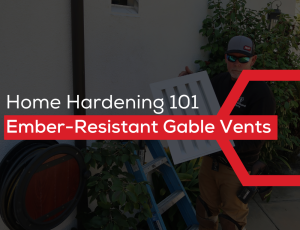
With over 7,500 wildfires in the state each year, fire safety is a top concern for California homeowners and property managers. When it comes to protecting your property from the devastation of a fire, two commonly used systems come to mind: fire vents and fire sprinkler systems. Each system is designed to mitigate the spread of fire and protect lives and property, but they operate in different ways and offer distinct advantages.
Here, the fire safety experts at Brandguard Vents explore the key differences between fire vents and fire sprinkler systems, discussing the key factors to consider when choosing the right option for your property.
The Difference Between Fire Vents & Fire Sprinkler Systems
Fire vents and fire sprinkler systems are both essential components of a quality fire protection system, but they serve different purposes and operate using different mechanisms:
Fire Vents
Also known as smoke vents or roof vents, fire vents are usually installed on a property’s roof. They’re designed to vent smoke, heat, and gases that accumulate during a fire, helping prevent the buildup of pressure and improve firefighters’ visibility. Fire vents are often activated automatically in response to heat or smoke detection or can be manually operated.
Fire Sprinklers
On the other hand, fire sprinklers are designed to suppress flames by spraying water or other extinguishing agents when a fire is detected. These systems consist of a network of pipes, sprinkler heads, and a water supply. When a fire is detected, the sprinkler heads closest to the source of the fire activate, releasing water to extinguish or control the flames.
Fire Vents & Fire Sprinklers: Factors To Consider
When deciding between fire vents and fire sprinkler systems, several factors should be taken into careful consideration, including:
- Building design & layout: Your building’s layout and design may influence the effectiveness of its fire protection systems. For instance, buildings with large, open spaces may benefit from fire sprinkler systems to ensure comprehensive coverage, while homes with multiple levels or compartments may require a combination of fire vents and sprinklers.
- Cost & maintenance: Evaluate each system’s initial investment and ongoing maintenance requirements. Fire sprinkler systems typically require more extensive installation and maintenance than fire vents, which may be a deciding factor for budget-conscious homeowners.
- Fire protection goals: Consider your primary objectives for fire protection. Are you more concerned with preventing the spread of smoke and heat or extinguishing the fire altogether? Fire vents are effective at venting smoke and heat, while sprinkler systems are designed to suppress flames.
- Local regulations & codes: Ensure compliance with California’s strict building codes and regulations governing fire protection systems. Some jurisdictions may have specific requirements regarding installing and maintaining fire vents and sprinkler systems, so familiarize yourself with what’s required in your area before making a final decision.
Schedule Service Today
Fire vents and sprinkler systems are valuable tools for protecting lives and property during a fire event. At Brandguard Vents, we specialize in installing fire-rated vents that offer the highest degree of protection for California properties. Our fire vents are CAL Fire listed and approved, compliant with SB721 and SB326 and Wildland Urban Interface regulations for your ultimate peace of mind.
Request fire vent installation in California by calling our team at 949-305-8059 today.





